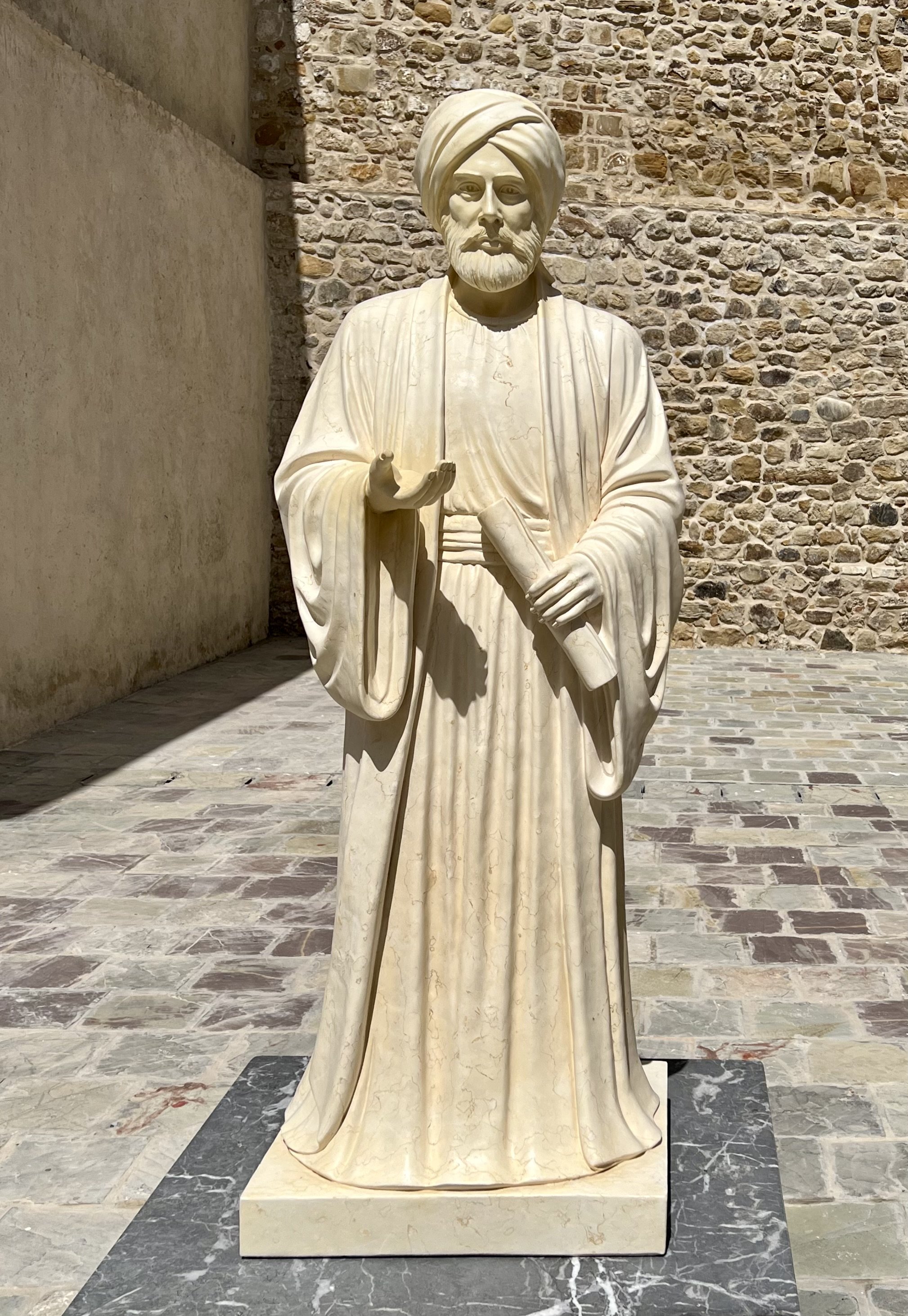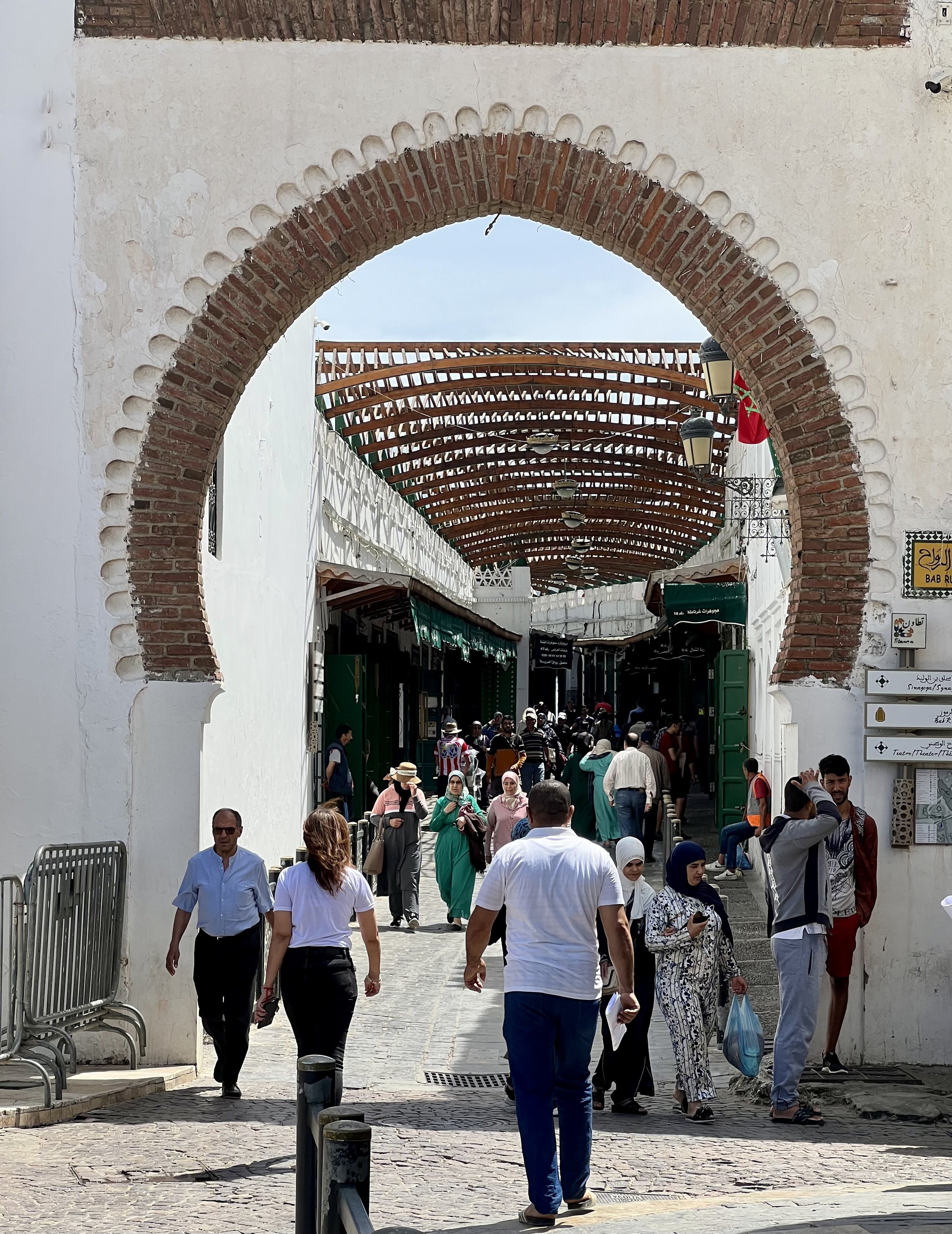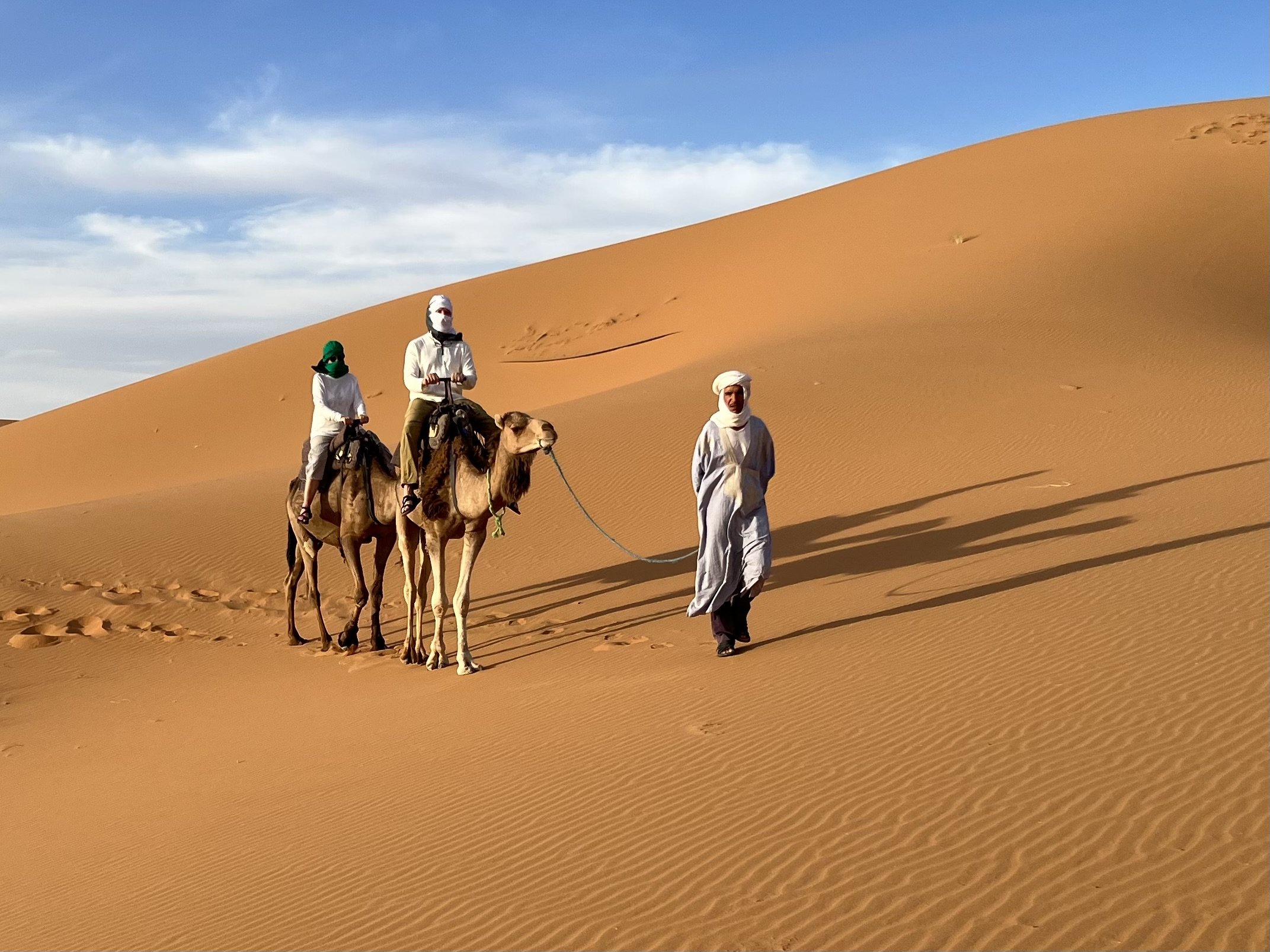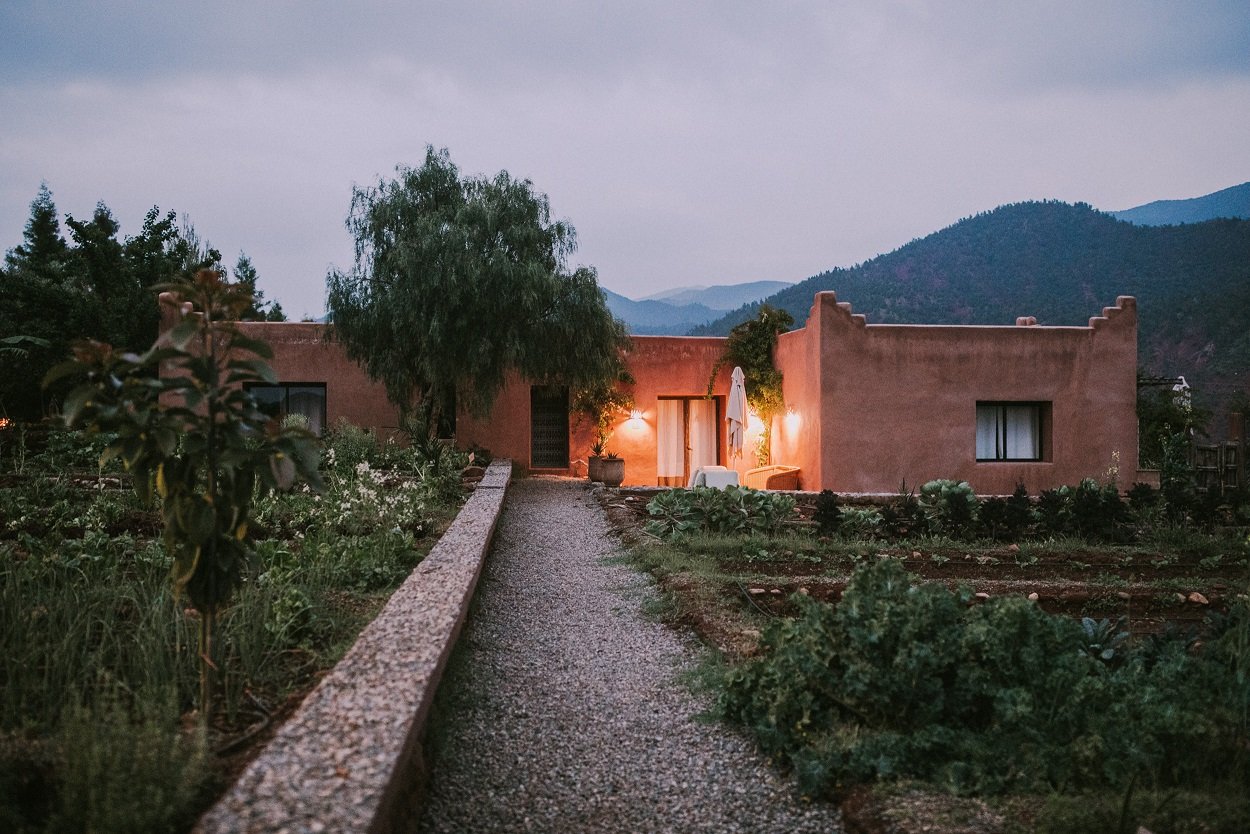Two Perfect Weeks in Morocco
Desert or coast, museum or market? Choose Your Own Adventure in a Country that Has a Lot of Everything
by Jennifer Szymanski and Chip Walter
The Sahara - Northwest Morocco (Photo-Chip Walter)
This page includes affiliate links. Vagabond Adventure will earn a commission if you make a purchase through one of these links, at no cost to you. But we only recommend and refer products and services we have used ourselves and thoroughly trust.
“I relish the idea that in the night, all around me in my sleep, sorcery is burrowing its invisible tunnels in every direction, from thousands of senders to thousands of innocent recipients. Spells are being cast…”
History, Romance, Intrigue - The Best of Morocco
Blame it on Bogie and Bergman. For many, the very mention of Morocco is bound inextricably with Casablanca, and the excitement and romance of classic Hollywood. And there's doubt the country offers plenty. Its history, its food, and its people. That was the fate of American novelist Paul Bowles [The Sheltering Sky], who in the late 1940s shed his tourist-bound moniker to settle in Tangier for the rest of his life.
Roughly the size of California, Morocco falls in the middle of a list of African countries ranked by size. It packs a remarkable amount of diversity into its borders, much of it due to its history. The land was once part of ancient Carthage, and later became the westernmost province of the Roman Empire. It has been sacked by the Portuguese and Moorish Spain, and, until 1956, was a French protectorate.
This rich history is evident in the tongues spoken by its peoples. About two-thirds of the population speaks Arabic, but Tamazight, the language of the collective indigenous peoples known as the Imazighen (Berbers) has been an official language since 2011. The tones of these languages mingle comfortably in the marketplace air with the sounds of French, Spanish, and, increasingly, English.
Morocco’s geography is similarly heterogeneous. As the only African country with coasts on both the Atlantic Ocean and the Mediterranean Sea, there is plenty of coastal life to experience. And, if you yearn for something more adventurous than the beach, you can also enjoy the high life. Thanks to Morocco’s two mountain ranges, Rif and Atlas, most of the country is about 2600 feet above sea level. Morocco’s border also encloses about 3% of the Sahara, Africa’s great desert which feeds the hot and dusty Sharqi winds that sweep across the land in early summer, influencing the country’s wildlife, agriculture, and cuisine.
Although taking in Morocco’s diversity in a few weeks may seem to be overwhelming, we think it's possible to manage while still absorbing something of its romance, history, and culture.
If you’re interested in the Vagabond Way, here are 10 experiences (almost) that we count as “can’t miss,” to get your journey rolling. If you're adventurous, you can decide which suit you best and pull together your very own exotic journey based on this article, or work with a travel service that can help you to navigate cultural waters and language barriers so you'll have more time to enjoy the trip rather than be frustrated by it. We planned our own itinerary with a lot of help from Frontiers Travel and their Moroccan colleagues Cobblestone Private Travel. More details on that below.
1. Cross the Straits of Gibraltar
We couldn’t think of a better way to enter Africa than to join millions of our fellow humans (both modern and ancient - the descendants of Neanderthals trekked these straits more than 400,000 years ago) by crossing the 8 or so miles between Europe and Africa. Today ferries shuttle people and freight continuously across the narrow channel.
Homo sapiens have been in northern Morocco more than 125,000 years, while the Rock of Gibraltar itself was very likely Neanderthal’s last outposts. [Read more in Chip’s popular, award-winning book Last Ape Standing, available here, or for free if you’re a member of Kindle Unlimited.] The famous promontory is currently a British Overseas Territory, and home to what are technically the world’s only wild European monkeys: a colony of roughly 300 Barbary Macaques.
But an easier way across the straits is to travel to the Spanish gateway town of Tarifa and board a FRS Direct Ferries ship. It's quick and painless and you'll spend a pleasant hour enjoying the refreshing breezes and coastal views. The ferries provide standard amenities such as a cafeteria and duty-free shop, and cost about $35 to $45 one way depending on the time of year.
V-A Insider Tip: We learned very quickly that it sometimes pays to carry cash. Read that story and more about our journey from Europe into Morocco.
The Straits of Gibraltar. Morocco lies at your feet. (Photo - Chip Walter)
2. Explore Tangier
Tangier’s name has long been linked with espionage, thanks to its reputation as a safe haven for spies during the Cold War, (not to mention being the site of SPECTRE headquarters in the James Bond universe, and the scene of a wild motorbike chase in The Bourne Ultimatum.)
We focused our surveillance on exploring as much of Tangier’s history and culture as possible. Don’t skimp on your time in this beautiful city. Two full days are recommended to get a proper taste of all that it has to offer— but if you have the time, spend more.
Whether you plan to have down time in Tangier or not, you might consider the El Minzah Hotel. We recommend it if you're looking for old-fashioned Hollywood style and feel. The rich and famous spent plenty of time here from the 1930s into the 1970s, and its great rambling grounds and charming architecture provide a touch of old and elegant Morocco today.
History buffs won’t want to miss the Tangier American Legation Institute for Moroccan Studies, the only U.S. National Historic Landmark in a foreign country. Not any of its many colorful souks (markets).
VA Insider Tip: Be sure to visit a recently created museum dedicated to one history's greatest travelers, Ibn Battuta who travelled the ancient world for 24 years. Read more about this kindred vagabond and our other adventures in Tangier. It’s easy to buy your tickets online.

|
A mind-bending techno-thriller. Get a copy of Chip Walter's Doppelganger |

|
A mind-bending techno-thriller. Get a copy of Chip Walter's Doppelganger. What if a murdered man could bring his murderers to justice? In 2024 Elon Musk announced the first computer-brain implant. In the year 2068 the first mind transplant becomes possible. Immortality is a reality. Except for Morgan Adams it’s not that simple. |
3. Visit the Souks of Tétouan
Morocco is home to nine UNESCO sites. The Medina (ancient city) of Tétouan is one of them. The city is small, but important in the history of the region and the world. Many of the people here still speak Spanish because thousands of Iberian Jews migrated to the city during the Inquisition when Catholic rulers tortured uncounted Jews and forced them to be baptized or exiled from all lands controlled by Spain.
Tétouan is steeped in ancient history too, and remains one of the best places to find artifacts of human life from long ago. The Tétouan Archaeological Museum has relics that date back to 200 BC. Should you be more curious about contemporary art, Tétouan is home to one of Morocco’s two schools of fine art, as well as a modern art museum.
VA Insider Tip: No pictures, please. Taking pictures is generally discouraged in Tétouan's souks. Generally throughout Morocco, before you snap, ask permission. If you have a guide, work with him or her. To see some of the ones we were able to get, read more about our experience in Tetouan.
Entering the souks of Tétouan. (Photo - Chip Walter)
4. Experience the Beauty of Chefchaouen
There are competing theories as to why the walls of Morocco’s “Blue Pearl” are shades of vivid blue. Some say it was a plan to reduce the mosquito population, others think its meant to remind residents of heaven, and inspire them to lead a spiritual life. Other locals are more pragmatic, and claim they were painted in the late 1970’s to attract tourists, which it certainly does. Whatever the reason, the effect is dazzling, and the city from a distance is reminiscent of a pattern on Delft pottery.
Another UNESCO site, Chefchaouen is well traveled by backpackers thanks to its proximity to the cool Rif Mountains and foothills. The Bouhachem Regional Nature Reserve and Talassemtane National Park protect the region’s diverse wildlife, including its fir and pine forests, which are under threat.
We spent only half a day in Chefchaouen, not nearly enough. (We recommend at least a full day.) The artful Medina is small, though, and you can do it justice in a day. If you’re planning on doing some hiking, you can add a second day and stay in a local village gîte (vacation home).
Like many Moroccan cities, Chefchaouen boasts a citadel called a Kasbah. The one we visited dates to the 15th century, and functioned as a residence as well as an arsenal and prison. To see video footage of the inside, visit our Dispatch XXIX - Exploring Morocco’s Exotic Cities: Tangier, Tétouan and Chefchaouen.
VA Insider Tip: In 2027 the Blue City will be directly in line with another full solar eclipse. Prepare now to stay in this charming town when when the sun disappears. Places to stay will be scarce, but the experience will be life-changing. Again, check with your local tour office or Frontiers Travel (ask for Kim Shumaker mention Chip and Cyndy) in the US or Cobblestone Private Travel in Morocco to make arrangements ASAP.
The Blue Pearl and its equally irridescent Medina. (Photos - Chip Walter)
5. Walk the Timeless Medinas of Fez
The tasseled fez is purported to have gotten its name from Morocco's second largest city, once the source of the berries that gave the hat its distinctive red color. Also known as a tarboosh, its brimless design was developed to allow devout Muslims to press their foreheads against the ground during prayer. In Western culture, wearing a fez suggests leisure, ceremony, and pageantry.
The fez is a fitting symbol when you explore its namesake city. Considered to be the spiritual and cultural capital of Morocco, Fez sits at the confluence of the Rif and Middle Atlas Mountains, its bustling urban center dependent on the Fez River (Oued Fes). Its atmosphere can only be described as electric.
Art is everywhere. In addition to visiting the Chouara Tanneries - (look for more in Dispatch XXXIII coming soon!) loaded with handcrafted bags, shoes and every other possible leather good, and trying our hands at pottery at Art de Poterie, we took in the Nejjarine Museum of Wooden Arts & Crafts. We suggest three to four days in Fez, though you could certainly spend more.
VA Insider Tip: Two Wheels or Less, Please. Yet another UNESCO World Heritage Site, the Medina in Fez does not permit cars to drive on its streets (not that most alleys are wide enough to accommodate them.) Pack comfortable shoes (or buy some at the Chouara Tanneries.) Check out our Fez adventures in Dispatch XXX including a walk through its Medina.
The rambling Medias of Fez. (Photo - Chip Walter)

|
Caught these dunes just before sunset. They rise 100s of feet and evoke David Lean’s stunning scenes in his masterful movie Lawrence of Arabia. The Sahara- print or digital images available. |

|
Caught these dunes just before sunset. They rise 100s of feet and evoke David Lean’s stunning scenes in his masterful movie Lawrence of Arabia. The Sahara- print or digital images available. |
6: Step Back in Time in Volubilis
Morocco’s volatile history is literally etched in the stone of this powerful city, once the southwest seat of the Roman Empire, now 30 minutes drive outside of Fez. The ruins at this UNESCO site bear evidence of 20 centuries of occupation, from prehistory through the 14th century. Time and an earthquake in 1755 destroyed many of its buildings, but what remains offers a fascinating glimpse into the lifestyles of multiple peoples and cultures.
Before the visit we stayed at the excellent Riad Anata (Book your stay) in Fez and then made the half hour drive to the ruins courtesy of our guide Youssef and Jabriel, our driver, who worked with Cobblestone Private Travel. Once there, we met at the site's modern museum and marveled at bronze and marble statues and intricate mosaics that lay at the boundary of the old city, one example after another of mostly Roman art, sculpture and architecture.
Redouane, a museum docent, then led us outside among the ruins to absorb its acres of history. You can read more detail about our experience, and view what remains of the partially reconstructed city. Volubilis - Ancient Rome Speaks.
VA Insider Tip: It can get hot when visiting Volubilis. Be prepared with SPF 50, water, and a hat. We were there late morning and temperatures had already hit 100 degrees F in late May.
The Ruins of Volubilis. (Photo - Chip Walter)
7: Watch the Sunset on the Sahara
Earth’s greatest desert is a place of paradoxes. Its barren landscape feels intimidating but somehow exhilarating. Temperatures can soar well beyond 100 degrees F then plunge to points near freezing at night. Its dry sands originated over long epochs, sometimes verdant, sometimes arid, formed by the erosion of rocks made of ancient compressed river sediment. Its name, while not exactly a paradox, is at least a redundant misnomer. Sahara means “desert” in Arabic.
Ismail, our trusted driver and guide (highly recommended), led us from Fez to the Sahara along roads that wound us through the Middle Atlas Mountains. We passed a bewildering number of climates en route, from forests where it sometimes snows, to vineyards and orchards. We even passed among a troop of Macaque monkeys until finally watching a caravan of camels lope along the road. See Into the Sahara.
Near the town of Merzouga are tourist settlements where you can stay in air conditioned comfort and take a short camel's ride into vast dunes hundreds of feet high that roll to the horizon. The sunsets are unlike anything you have ever seen. Travel can be arranged through Cobblestone Private Tours or contact Ismail directly for car service and other travel arrangements.
What’s it like to ride a camel? Nothing quite like it. Humans have been living and working alongside camels for at least 4,000 years. It’s no wonder — being native to the Arabian peninsula — that they are supremely adapted to desert conditions. Their gait is much different than that of a horse, as they tend to pace along moving both front and hind legs on the same side together in a stride. The result feels a little like riding a great rocking chair.
Should your adventures take you to this part of the world, we recommend allowing at least two days, one for travel, and one for exploration. For details about our Sahara trek (and more on what it’s like to ride a camel), check out Into the Sahara.
VA Insider Tip: On the road from Fez to Merzouga, spend a night or at least a lunch at the L'Ma Lodge (ma means water in Arabic) which sits in the heart of the Skoura Oasis. Here, in this ancient river bed, Vanessa and her husband began work 18 years ago to create the lodge which is nestled among green palms, olive trees, excellent rooms and restaurant where you can walk among the trees or swing yourself to sleep in a hammock. La Ma is really an oasis within an oasis, a remnant of the "Green Sahara" that once spread throughout this arid land.
The Sahara — a once in a lifetime experience. (Photo of Cyndy and Chip unknown.)

|
Every idea begins in your mind, but to become a reality it must find its way into the world. Taken an hour before sunset in Merzouga, this a perfect image to put on a traveler's journal. The Sahara Traveler's Journal. |

|
Every idea begins in your mind, but to become a reality it must find its way into the world. Taken an hour before sunset in Merzouga, this a perfect image to put on a traveler's journal. The Sahara Traveler's Journal. |
8: Marrakesh
Marrakesh (or sometimes Marrakech) is Morocco's fourth largest city. Its name alone speaks of exotic locations like Tombouctou, Khartoum, Petra or Kathmandu. Traveling by train, air or car will get you there, but we prefer the slow way. Long a center of commerce and learning, the city gained fame as a hippie hangout in the 1960s and 1970s, and inspired the Beatles, the Rolling Stones, and Led Zeppelin (or they at least had a good time while they were there). Graham Nash wrote the popular song Marrakesh Express while he was a member of Crosby, Stills and Nash.
The Djemma el Fnaa [pronounced Jah-myah el Fah-nah)], the city’s main square, is a sight to behold. Performance art of all kinds fills this vast marketplace, and has done so for 1000 years. Dancers and snake charmers vie for space and tourist attention during the day, while, at night, the smells of barbecue, fruits and the sound of music hang heavy in the air. It is a riot of color, sound and vibrant human activity.
But this is only part of the old city where its centuries old labyrinthine Medina winds past hundreds of souks, riads, mosques and restaurants. Be sure you spend three days here as part of your Moroccan adventure. We stayed at Riad Dar Sara and highly recommend it. Book online here.
The sites within this city are many and varied. You may not be able to visit all of them, but try to explore Dar El Bacha, built for Pacha Thami El Glaoui, who ruled over Marrakesh from 1912 to 1956. It is one of the Medina's finest examples of Moroccan riad architecture and features exhibitions focused on Moroccan culture. Or visit the grand Mnebhi Palace that now houses the Musée de Marrakech. For lunch try L’Mida, a stylish rooftop restaurant with a pleasant view of the city.
VA Insider Tip: Dinner at Dar Zellij, a beautiful 17th century Dar (large house) in the old city known for its mouthwatering tagines and the classic Moroccan beauty of the Dar itself.
The back patio of the Dar El Bacha. (Photo - Chip Walter)
9. Rabat
Located where the river Bou spills into the Atlantic, Rabat is Morocco’s capital city, as well as its seventh largest. It became infamous in the 17th century for its association with Barbary Pirates because its harbor was both ideal for attacking passing ships and excellent for launching raids on Europe's coastal cities.
Given that Rabat is Morocco's political center, it is a more somber stop than Marrakesh, but that also makes it less “touristy.” We recommend the Riad Kalaa and suggest arranging its private hammam there. Excellent! (Coming soon, read about Chip's hilarious hammam experience.)
Rabat's Medina is not as big as those in Marrakesh or Fez, but there's still plenty to see, especially around the harbor where children play and locals playfully row back and forth in the harbor at the foot of the mighty Atlantic. Travel via ONCF (Office National des Chemins de Fer), Morocco’s national railway. It is safe, fast, comfortable and reasonably priced. For grand views of the nation's coast and interior, you can take the train from Marrakesh to Rabat (Via Casablanca) and then Rabat to Tangier (as we did). Both Coach and First Class are available. Book here.
VA Insider Tip: ONCF is a rail system that links all of northern Morocco's major cities and its fast, modern trains are as well run as any in Europe. For more information visit: Office National des Chemins de Fer.
Ruins outside of the Rabat Medina (Photo - Chip Walter)
10? Wait, What about Casablanca?
(Or, of all the gin joints in all the world… why we chose to not walk into Ricks’.)
Sharp-eyed vagabonds will notice that Casablanca didn’t earn a “can’t-miss” rating on this list. Why not? What we heard from several Moroccans was that it was not the exotic location its name inspires, (at least not these days). It’s big, busy, and modern, a Moroccan New York, and there’s not much there that is as uniquely Moroccan as the other places on the list.
Since neither Rick nor the cafe ever really existed, we felt there were better places to visit, especially if you're exploring the country inside of two weeks. On the other hand, if you like, you can easily reach Casablanca (and a variety of fake Rick’s Cafes) by train from any major city in the country.
In Short
Morocco is one of those places you have to consider visiting. There’s simply too much history, excellent food, exotic locations and wonderful people. Costs are reasonable and you can cover so much in a relatively short time. The country somehow manages to be both modern and ancient at the same time. Travel “on the shoulder” to get the best deals and avoid the heat: February to Mid-May or October to December. You won’t regret it.
We feel you can pack all of these explorations into two weeks, but if you have the time, explore our recommendations below and feel free to take longer if you have the time! Just be sure to pack your hiking boots, plenty of warm clothing (in layers), and a camera!
More Recommendations for Your Moroccan Visit
We’ve done our best to curate the best of our own Vagabond experiences in Morocco. Here are several recommendations for food, lodging and adventure. Visit our entire collection of Moroccan Recommendations to get the latest “complete” list (check often as we frequently add new recommendations)


















“Expertly planned Morocco journeys for culturally curious travelers.
Cobblestone’s founder, Michael Diamond, has been named to Travel + Leisure's A-List on Morocco Travel for the last 7 years. Conde Nast Traveler named him as their 2016 Top Travel Specialist for Morocco.
With nearly two decades of experience designing private travel to Morocco, we want to share our excitement and passion for this unique destination with you. We want to enchant, challenge, and inspire curious travelers. Let us design a customized itinerary that reflects your interests but also, hopefully, surprises you with unforgettable experiences that only we can arrange.”